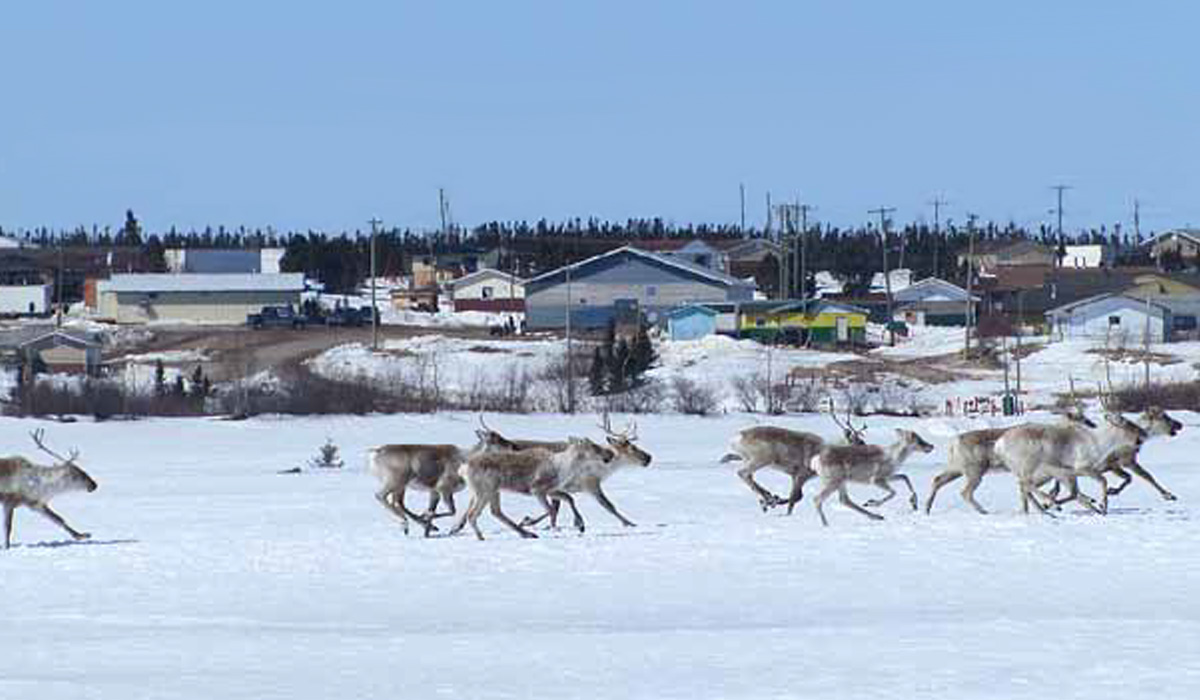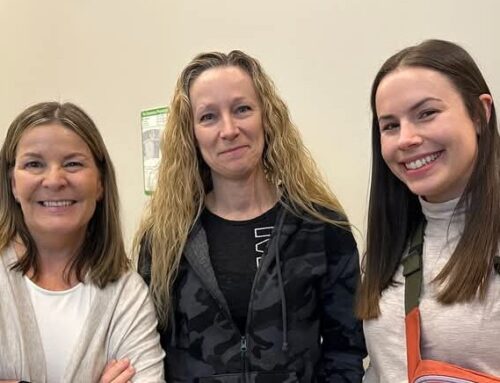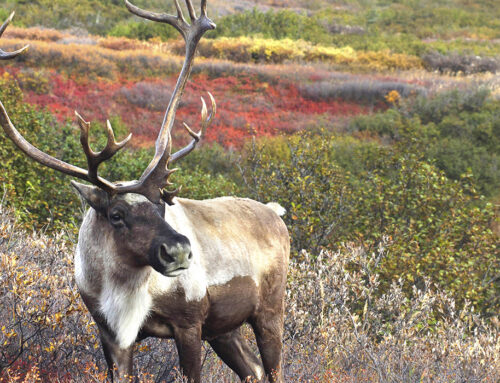ELDERS PROVIDE CRUCIAL VIEWPOINT
In order to understand the present, it’s important to know the past.
Elders have acquired a lifetime of memories and valuable experiences, and they hold powerful knowledge about the effects of change on caribou, about caribou calving grounds, and the way shifting weather patterns affect the health of caribou herds and hunting. The BQCMB hopes to capture that knowledge during interviews with Baker Lake and Arviat elders in spring 2003.
The project is a partnership with the University of Alaska Fairbanks/Institute of Arctic Biology. The findings will greatly benefit the BQCMB’s community-based caribou monitoring project and help the BQCMB achieve its goal to document local knowledge of historical caribou distribution and movements. BQCMB community representatives and Baker Lake and Arviat Hunters and Trappers Organization (HTO) board members requested this course of action during discussions on hunter interviews conducted in 2001 and 2002. Interviewing the elders will also contribute to a continent-wide project on caribou and climate change sponsored by the International Arctic Science Committee.
Each community’s HTO will select eight elders to be interviewed. Together, a translator and the recently hired BQCMB community liaison Anne Kendrick will conduct the interviews. (Kendrick, a University of Manitoba PhD student, has worked in communities on the caribou range before while studying traditional ecological knowledge, and co-management.) The recorded interviews will be translated and organized according to themes, with the findings being presented to each elder and HTO for review.
The BQCMB will learn about results from these interviews at its November 2003 meeting, and a final report will go to Baker Lake and Arviat HTOs, the BQCMB and others. In order to make this knowledge more widely known, several papers will be written for scholarly journals, and digital copies of the audio recordings will be archived with the University of Alaska Special Collections Department, as well as the HTOs and the BQCMB.
Financial support will be requested from the Nunavut Wildlife Management Board, without whose help the community caribou monitoring program would not have been possible. Meanwhile, the Nunavut Planning Commission has already offered support in-kind.
AROUND THE RANGE
NPC lends a hand
David Aksawnee and other BQCMB members took turns describing the recent movements of caribou in their area and more during the board’s November meeting. Arviat regional biologist Mitch Campbell (far right) looks on
The Nunavut Planning Commission (NPC) has offered to help the BQCMB caribou monitoring project by providing Inuktitut placename maps for the Kivalliq Region to aid the BQCMB during interviews, as well as mapping expertise to analyze and display the data collected. The BQCMB, in turn, will share information from its monitoring project with the NPC. The BQCMB just completed a second round of interviews with hunters in Arviat and Baker Lake, and will soon interview elders there. The NPC is responsible for land use planning in the Nunavut Settlement Area, and has amassed 2,000 Inuktitut placenames in the course of research so far.
Caribou Scholarship deadline
January 31, 2003 is the deadline for applications to the Beverly and Qamanirjuaq Caribou Management Scholarship Fund. This award helps full-time students whose studies contribute to the understanding of barren-ground caribou and their habitat. Preference goes to applicants from a caribou-range community and to those examining the Beverly and Qamanirjuaq herds. To apply, contact the Association of Canadian Universities for Northern Studies. Tel: (613) 562-0515, or fax (613) 562-0533. Web site: www.cyberus.ca/~acuns
Making plans
Call it coincidence, but hunters, scientists and others are working on long-term caribou management plans from Nunavik to Alaska. The Hunting, Fishing and Trapping Coordinating Committee along with the government of Quebec have authored a comprehensive 2003 – 2008 plan for the neighboring George River, Leaf River and Torngat Mountain herds. A draft 10-year plan with action plans to manage the Bathurst Herd, located in the heart of diamond mine country, goes to the Bathurst Caribou Management Planning Committee in February, and should be in place by July. The BQCMB is revising its plan for 2002-2007, and in Yukon, members of the Porcupine Caribou Management Board will be hammering out a 2003 – 2006 plan. Finally, in northwest Alaska, the Western Arctic Caribou Herd Working Group has sent out more than 400 copies of its long-term draft plan for public review, and will approve the plan in 2003. For the first time ever, collaboration guided the process: the people who use and value the animals are writing the plan with agency assistance. The process is “firmly rooted in the principles demonstrated by the BQCMB,” says John Trent of the Alaska Department of Fish and Game, “notably shared decision-making and co-management.
“The BQCMB has always been a role model for what we are trying to accomplish in northwestern Alaska.”
BQMCB meetings
It will be springtime in northern Saskatchewan for the BQCMB. Members plan to descend on Fond du Lac for their May 30 – June 1, 2003 meeting. Then it’s back to Winnipeg for the board’s fall assembly, Nov. 14 – 16, 2003.
ONGOING MONITORING FINDS THE HERDS ARE HEALTHY
Baker Lake caribou monitor Betsy Aksawnee
Good news: in the year leading up to fall 2002, the caribou were healthy and close to communities, hunters from Baker Lake and Arviat related as round two of interviews in the BQCMB’s caribou monitoring project got underway in October and November. The project began in 2000 and is studying caribou, caribou range and community use in relation to climate change and land use activities such as mines and roads.
This community-based monitoring system, which has the full support of the communities’ HTOs, addresses common concerns about the health of individual caribou and the herds as a whole, the potential impacts of climate change and development activities on the herds and their habitat, and will facilitate decision-making by governments.
Hunting increases with new road
Between the winter of 2001/2002 and fall 2002, hunters in Baker Lake and Arviat reported the caribou were close to the communities during spring and fall migrations. In spring, “the caribou had no problem digging to feed because there was not much snow and the snow melted earlier than most other years,” reported Baker Lake caribou monitor Betsy Aksawnee. Fall weather was wet, warmer and mostly windy with few storms.
Arviat caribou monitor Mike Curley, who carried out interviews in 2001 as well, said hunters noticed that water levels were higher than usual in Maguse River near Arviat from summer through to fall, and there were fewer berries. Caribou hunting increased significantly around the Maguse Lake area where a new road is under construction, and Curley added that boats and cabins are also on the rise around Maguse Lake.
“I think that people in Arviat are not really aware of the effects that the new road will have on the caribou migration and environmental conditions in the future,” he said, “because that is the area that the caribou migrate through in the spring and fall-time.”
Measuring progress so far
The BQCMB will now evaluate progress from the Kivalliq interviews to make sure the overall project meets the needs identified in the new Management Plan.
In order to fine-tune its efforts, the BQCMB monitoring team will use feedback from caribou monitors, HTOs, BQCMB members and others to improve project methods, and decide how to make the project efficient for long-term sustainable use.
Aksawnee and Curley noted, among other things, that it’s hard to get good answers about weather, since weather varies throughout a season, or individuals experience different aspects of that season’s weather.
The overall project will also strengthen links with other community-based caribou monitoring programs. Lutselk’e, for example, has already been running its own wildlife monitoring project for some time. Steve Ellis and Nancy Casaway of the Lutselk’e Dene First Nation’s Wildlife, Lands and Environment Committee updated BQCMB members about that program in November.
In response to requests from Saskatchewan, the BQCMB will investigate ways to start similar caribou monitoring in some of the Athabascan communities where the Athabasca Land Use Planning (ALUP) Interim Advisory Panel has been collecting traditional knowledge and mapping caribou harvesting sites. ALUP received $30,000 in federal funding to map traditional land areas of the Athabasca First Nations. The Panel is willing to work with the BQCMB.
Caribou News in Brief stories covering this project since December 2000 are now online in Inuktitut at www.arctic-caribou.com/publications_newsletter.html
NEW BOARD TACKLES RENEWED MANDATE
There’s lots of new blood within the BQCMB, a widescale change that coincides with the board’s new 10-year mandate, renewed by the governments of Canada, Manitoba, Saskatchewan, the NWT and Nunavut. Some major challenges ahead on the caribou range include climate change, unprecedented mineral development and construction of roads and other infrastructure.
The new board members are David Aksawnee, president of the Baker Lake HTO, Joe Kaludjak, president of the Rankin Inlet HTO, Stephen Traynor, director of operations for the Nunavut Regional Office of Indian and Northern Affairs Canada (INAC), Chris Heron, representing the Northwest Territory Métis Nation, and George Tsannie of Wollaston Lake.
Here’s a look at the new BQCMB:
- Jimmy Laban, chairman (community representative, northern Saskatchewan)
- Tim Trottier, vice-chairman (government representative, Saskatchewan Environment, government of Saskatchewan)
- David Aksawnee, member (community representative, Kivalliq Region, Nunavut)
- Joe Kaludjak (community representative, Kivalliq Region, Nunavut)
- August Enzoe (community representative, South Slave Region, NWT)
- Chris Heron (community representative, South Slave Region, NWT)
- Billy Shott (community representative, northern Saskatchewan)
- George Tsannie (community representative, northern Saskatchewan)
- Albert Thorassie (community representative, northern Manitoba)
- Jerome Denechezhe (community representative, northern Manitoba)
- Stephen Traynor (government representative, INAC, government of Canada)
- Vacant (government representative, Manitoba Conservation, government of Manitoba)
- Deb Johnson (government representative, Department of Resources, Wildlife and Economic Development, government of the NWT)
- Dan Shewchuk (government representative, Department of Sustainable Development, government of Nunavut)
Some members may also have alternates. The board’s sole staff member, longtime secretary-treasurer Gunther Abrahamson, remains with the BQCMB.
INAC IS BACK
INAC Minister Robert Nault, flanked by BQCMB secretary-treasurer Gunther Abrahamson (right) and Nunavut’s Member of Parliament Nancy Karatek-Lindell (left), puts his name to the renewed Beverly and Qamanirjuaq Barren Ground Caribou Management Agreement
INAC, one of the government departments that created the BQCMB in 1982, has rejoined the board after a three-year absence.
INAC and Environment Canada withdrew their representatives from the board in 1999 when Nunavut officially became a territory and signed on to the Intergovernmental Caribou Management Agreement. The federal government pulled out in part because more local wildlife management responsibility was being assumed by the new Nunavut government, and partly because the federal government was attempting to reduce its deficit. INAC, however, never ceased its financial support.
COMMERCIAL QUOTAS GET THE GO-AHEAD
New figures that show more Qamanirjuaq caribou could be hunted without hurting the herd’s long-term health paved the way for BQCMB recommendations on several new commercial quotas, including an extra 1,500 animals for Rankin Inlet, home to fish and meat processing plant Kivalliq Arctic Foods.
The Rankin Inlet HTO wants the sizeable increase in tags in order to afford the purchase of a portable abattoir, explained HTO president Joe Kaludjak. That in turn would create more jobs for hunters as well as the processing plant. Kivalliq Arctic Foods earned certification under European Union standards in 2001, making it the first Canadian firm to export caribou meat to Europe.
The BQCMB also recommended that the Nunavut government approve 75 more outfitting tags to the Baker Lake HTO.
Recent figures from the Harvest Study conducted by the Nunavut Wildlife Management Board (NWMB) provide much-needed statistical overviews of harvesting among the Qamanirjuaq herd. According to BQCMB calculations, an additional 3,600 caribou could be safely allocated for hunting, based on the NWMB’s data. Hunters also monitor the Qamanirjuaq herd regularly, and have reported large sightings.
Harvest figures for the Beverly caribou, however, remain sketchy. The BQCMB is continuing to refuse endorsements of more commercial tags from that herd in the absence of population surveys.
Another request for more outfitting tags under the Qamanirjuaq herd is on hold until residents in northern Manitoba communities can be asked for their opinions.
Outfitters there have been running half-full aircraft to lodges, and want to bring in 15 more hunters to each of the region’s five lodges. Since each hunter is allowed to bag two animals, that works out to 150 more tags for the lodges. An increase in the quota for outfitters would be matched by an increase in community outfitting activities, so 60 more tags are being requested for community outfitters at the same time.
Still, such a scenario would widen the market share for outfitters considerably, boosting their current 125 hunts available to sell to 200, while the community share would move only from 70 hunts to 100.
BQCMB Manitoba board members will bring back the results of their discussions with communities at the May 2003 meeting.
BRAINSTORMING BRINGS NEW APPROACH ON SURVEYS
Faced with the need to update the Beverly and Qamanirjuaq Management Plan 1996-2002, the board’s biologists met for two days just before November’s Winnipeg meeting to deliberate on, among other things, better ways to count caribou.
While the bulk of the new Management Plan has yet to be debated at the BQCMB’s next meeting, the board did endorse three recommendations immediately.
Satellite collars a must before surveying
One of the most significant recommendations relates to overdue caribou population surveys. Until 1988, governments did calving ground surveys at two-year intervals. In 1990, it was decided that given the level of precision, and the high cost of these surveys, they should be conducted every six years. But the Beverly and Qamanirjuaq caribou haven’t been counted since 1994, not only because surveys are costly, but because they sniff out only dramatic population changes. Plus, other more inexpensive types of caribou monitoring haven’t been done regularly, and these could prove whether a costly population survey is needed or not.
At the government of Nunavut’s request, the board worked on new guidelines for using surveys. Nunavut called for a new management scheme that incorporates hunter observations and uses less costly tools like reconnaissance surveys as a first step in population analysis. The new guidelines say that before doing a survey, there must be:
- satellite collars on some animals in the herd. Collars are key to pinpointing where the caribou are – otherwise, a survey could come up with an incorrect low number
- caribou monitoring by communities and biologists (for example, measuring the back fat on caribou regularly, paying hunters to report the abundance and frequency of caribou, doing reconnaissance surveys). Monitoring won’t provide exact numbers but will show generally whether the herd is increasing or decreasing, and with a variety of monitoring systems, a better overall picture of the herd will be drawn. Monitoring will provide the clues that will trigger a survey or not.
In Lutselk’e, hunters are already doing such monitoring of the Bathurst caribou herd to the north. Some animals from this herd also wear satellite collars to furnish information on their whereabouts.
“Satellite collars are pretty good,” BQCMB member August Enzoe of Lutselk’e told fellow board members.
Over the past 10 years, a handful of Qamanirjuaq cows have also worn satellite collars. The Beverly herd, however, has never been collared because of opposition from some Athabascan communities.
BQCMB chairman Jimmy Laban, who is from Black Lake, informed the board at recent meetings that opinion had turned and communities generally backed collaring. Laban was asked to obtain written supporting resolutions from bands in the region, or from an assembly that represents each of the bands, in order to satisfy governments that there is firm community support in Saskatchewan before satellite collars are purchased. Laban told Caribou News in Brief that he would be asking for resolutions at a Chiefs Symposium slated for early February. “I don’t think it will be a problem,” he said.
Two other changes okayed
Recognizing that caribou need protection during special times, like the rutting season and calving season, the board also agreed to recommend that sports hunters be banned from shooting bulls between October 1 and November 30, and caribou between May 15 and July 31. In step with this, board members supported a recommendation that the domestic use of caribou will always be protected – even if commercial use is reduced.
Reconnaissance survey results
A June 2002 reconnaissance survey of the Beverly herd showed lower than usual densities of caribou on the calving grounds (9.1 caribou per square kilometre) but given the late spring weather, 2002 “was maybe not the best year to do this work,” RWED regional biologist and survey organizer Deb Johnson told her fellow BQCMB members in November. A large portion of breeding females calved to the southwest of the traditional calving area. What’s more, visual counts like these usually result in counts that err on the low side.
Reconnaissance surveys are fact-finding missions that delineate the calving ground and provide relative densities. One of Johnson’s recommendations is that these type of surveys be done regularly to glean more consistent distribution trends. This survey was the first to capture any kind of biological data on the Beverly herd since 1994.
PEOPLE AND CARIBOU
Warm hellos and sorrowful goodbyes marked the BQCMB’s November meeting in Winnipeg, as the newly expanded board welcomed new colleagues and bid adieu to several treasured veterans. Among them was chairman David Kritterdlik, a member since 1987. He and fellow Kivalliq Region member George Kuksuk, along with alternates Noah Makayak and Jacob Ikilnik, have been replaced by new members nominated by the Kivalliq Wildlife Board.
Whether at the board table or at international conferences, Kritterdlik always spoke passionately about the need for different groups to work together to manage caribou. Though he couldn’t attend the November meeting, his faxed farewell called it “a pleasure” to have served on the BQCMB, a group that was “effective in directing our different levels of government to focus on issues relating to the protection and management of our wildlife and environment.”
Voted new chairman was Saskatchewan community representative Jimmy Laban, while Saskatchewan government representative Tim Trottier fills the void of vice-chairman left when former NWT government representative Bas Oosenbrug departed the BQCMB a year ago.
Another board member gone is Manitoba government representative Cam Elliott, who moves to Churchill as Parks Canada’s superintendent of Wapusk National Park and Manitoba North National Historic Sites. On leaving, he called the BQCMB “a small group making good decisions,” one that “can take credit for ensuring that there has been no conflict between hunters, between jurisdictions, and between the various cultural and ethnic groups using the caribou.
“In my 10 years on the board, I have seen everyone and every government give a little to ensure we are putting the welfare of the herds first.”
The Winnipeg meeting packed a full house. In addition to the regular board faces were a number of alternate members: Adam Nalge of Lac Brochet, Arthur Beck representing the Northwest Territory Métis Nation, and Sam Boucher of Lutselk’e. Peter Kusugak of INAC’s Nunavut Regional Office filled in when INAC member Stephen Traynor had to leave partway through the meeting. Others in attendance were elder Jimmy Kkaikka of Wollaston, Jack Bird of the Fort Smith office of Resources, Wildlife and Economic Development, Mitch Campbell of the Arviat office of the Department of Sustainable Development, Nancy Casaway and Steve Ellis of the Lutselk’e Dene First Nation’s Wildlife, Lands and Environment Committee, Leslie Wakelyn and Anne Kendrick of the BQCMB caribou monitoring project, Nunavut caribou monitors Betsy Aksawnee and Mike Curley, and former BQCMB chairman Ross Thompson with Manitoba Intergovernmental Affairs – and now mayor of Stonewall, Manitoba.





